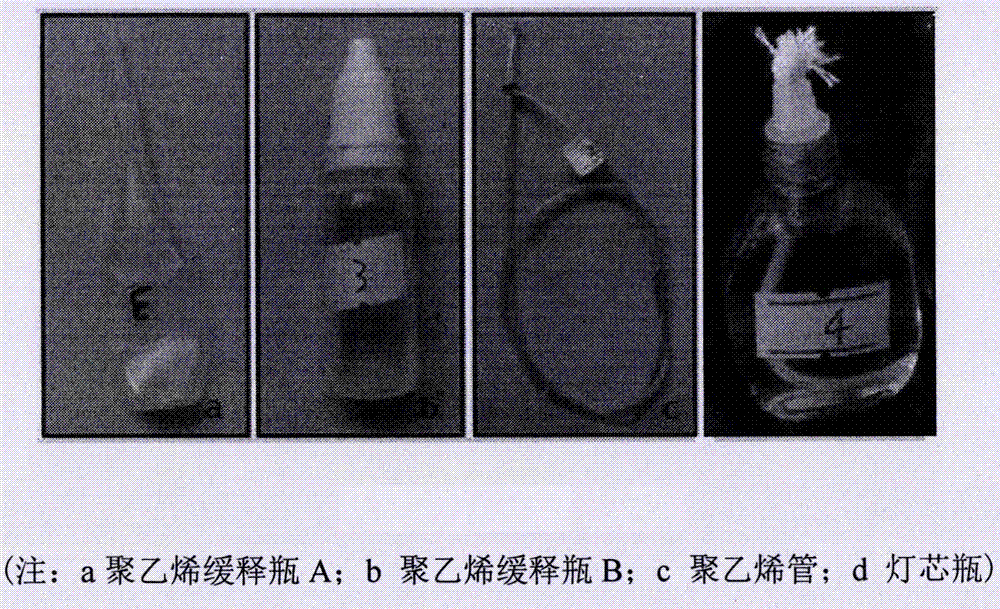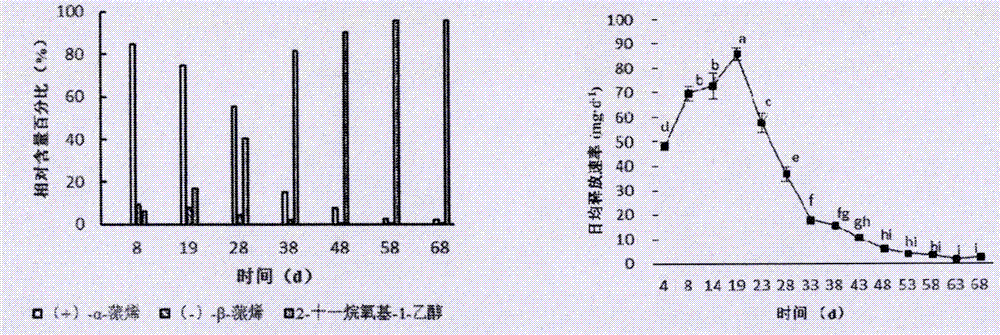Screening method of sustained-release materials for Monochamus ahernatus Hope semiochemicals
A technology of long-released long-term beetle and slow-release materials, applied in the fields of botanical equipment and methods, preservation of human or animal bodies, chemicals for biological control, etc.
- Summary
- Abstract
- Description
- Claims
- Application Information
AI Technical Summary
Problems solved by technology
Method used
Image
Examples
Embodiment 1
[0017] Preparation: (+)-α-pinene, (-)-β-pinene, and 2-undecyloxy-1-ethanol are formulated into a mixed solution of Monochamus alternatus semiochemicals in a ratio of 9:1:1. Use a pipette gun to transfer the semiochemical mixture to a low-density polyethylene (LDPE) slow-release bottle, and add it to the mouth of the bottle.
[0018] Determination: 7 groups were set up for experiments, 2 groups were used for GC analysis of the mixture ratio, and the other 5 groups were used for weighing to calculate the loss. To simulate the state of placing lures in the wild, hang the carrier lures on an impact-type Monochamus alternatus trap. A 7820A gas chromatograph (gas chromatograph 7820A, Agilent Company) was used for analysis, and the chromatographic column was a DB-5MS non-polar capillary chromatographic column (30m×0.25mm×0.25μm). Analysis conditions: heating program: keep at 80°C for 1min, then rise to 230°C at 5°C / min, and keep for 5 minutes. Samples 1 and 2 of the sustained-relea...
Embodiment 2
[0021] Preparation: (+)-α-pinene, (-)-β-pinene, and 2-undecyloxy-1-ethanol are formulated into a mixed solution of Monochamus alternatus semiochemicals in a ratio of 9:1:1. Use a pipette gun to transfer the semiochemical mixture to a high-density polyethylene (HDPE) slow-release bottle, and add it to the mouth of the bottle.
[0022] Determination: 7 groups were set up for experiments, 2 groups were used for GC analysis of the mixture ratio, and the other 5 groups were used for weighing to calculate the loss. To simulate the state of placing lures in the wild, hang the carrier lures on an impact-type Monochamus alternatus trap. A 7820A gas chromatograph (gas chromatograph 7820A, Agilent Company) was used for analysis, and the chromatographic column was a DB-5MS non-polar capillary chromatographic column (30m×0.25mm×0.25μm). Analysis conditions: heating program: keep at 80°C for 1min, then rise to 230°C at 5°C / min, and keep for 5 minutes. Samples 1 and 2 of the sustained-rele...
Embodiment 3
[0025] Preparation: (+)-α-pinene, (-)-β-pinene, and 2-undecyloxy-1-ethanol are formulated into a mixed solution of Monochamus alternatus semiochemicals in a ratio of 9:1:1. Due to the small hole of the polyethylene tube, inject 2mL of the semiochemical mixture with the injection needle, and seal both ends with a lighter.
[0026]Determination: 7 groups were set up for experiments, 2 groups were used for GC analysis of the mixture ratio, and the other 5 groups were used for weighing to calculate the loss. To simulate the state of placing lures in the wild, hang the carrier lures on an impact-type Monochamus alternatus trap. A 7820A gas chromatograph (gas chromatograph 7820A, Agilent Company) was used for analysis, and the chromatographic column was a DB-5MS non-polar capillary chromatographic column (30m×0.25mm×0.25μm). Analysis conditions: heating program: keep at 80°C for 1min, then rise to 230°C at 5°C / min, and keep for 5 minutes. Samples 1 and 2 of the sustained-release c...
PUM
 Login to View More
Login to View More Abstract
Description
Claims
Application Information
 Login to View More
Login to View More - R&D
- Intellectual Property
- Life Sciences
- Materials
- Tech Scout
- Unparalleled Data Quality
- Higher Quality Content
- 60% Fewer Hallucinations
Browse by: Latest US Patents, China's latest patents, Technical Efficacy Thesaurus, Application Domain, Technology Topic, Popular Technical Reports.
© 2025 PatSnap. All rights reserved.Legal|Privacy policy|Modern Slavery Act Transparency Statement|Sitemap|About US| Contact US: help@patsnap.com



